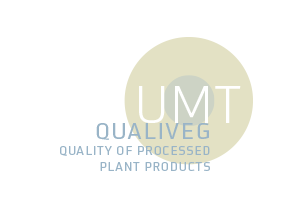
Coordination
Partners
Objectives
The QUALIVEG joint technological unit combines the evolution of antioxidant micro-constituents and the estimation of the danger of microbiological alteration by highly thermophilic bacteria, in a benefit/risk approach to plant product processing. These two aspects are connected by modelling approaches to help improve the nutritional and food safety properties of canning processes for fruit and vegetables.
This joint technological unit, located in Avignon, started its five-year programme in 2011.
Actions
The joint technical unit's scientific and technical programme is focused on three areas:
The reactivity of micro-constituents and interactions with the food matrix during the processes.
As fruit and vegetables have complex matrices, the behaviour of their antioxidant micronutrients (vitamins C and E, provitamin A, as well as carotenoids, and polyphenols), their macro-constituents and their interaction during production processes are studied in simple and more complex media. These approaches make it possible to control parameters such as oxygen content, pH, redox potential, and temperature, among others.
Depending on these conditions, reactional and stoichiometric models are prepared in order to allow for the evolution of micro-constituents depending on technological parameters.
Characterisation of microbiological difficulties.
The microbiological difficulty considered is alteration due to the presence of non-pathogenic, thermophilic, highly thermoresistent bacteria like Geobacillus stearothermophilus and Moorella thermoacetica. The objective is to define the production stages that are critical for micro-organisms and, for each one, to establish:
- the nature of the biological processes that take place (microbial inactivation or growth, cross-contamination);
- the factors to take into account (temperature, pH, oxygen, etc.).
Optimisation of production processes with difficulties and feasibility
The optimisation processes take place in two phases by:
- in silico modelling to guarantee the nutritional qualities (phase 1) with microbiological difficulties (phase 2),
- pilot or industrial-scale production to illustrate the technical feasibility of these solutions and identify industrially acceptable solutions.





